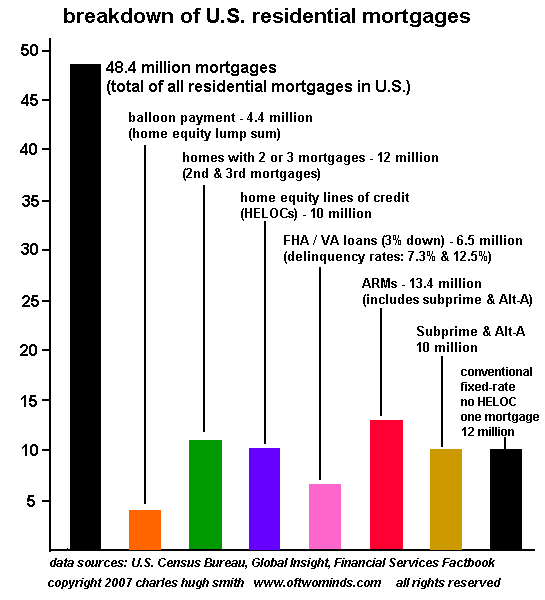

|
| weblog/wEssays archives | home | |
|
The Mortgage Mess: The Soft Underbelly Beyond Subprime (April 10, 2007) Our Fearless Financial Leaders (Secretary of the Treasury Henry Paulson and Fed Chairman Ben Bernanke) have reassured the nation again and again that the "subprime mortgage meltdown" is safely "contained" and will not touch a hair on our dear economy's fine head. Before you accept those warm and fuzzy reassurances, take a good long look at this chart I've prepared from three sources of data: 
These numbers blow the doors off the "containment" theory. Rather than being limited to a few million mortgages, the risks of re-sets or sinking equity affect fully 75% of all households holding mortgages in the U.S. Let's look at the sources and the numbers. The first thing to note is that no one tracks the number of subprime and Alt-A (no document) mortgages, but it's possible to derive a fact-based guesstimate from other data. Our first source: the U.S. Census Bureau's American Housing Survey (AHS). Unfortunately, the Survey is presented in a totally confusing welter of overlapping categories and lists. But a careful reading unearthed these telling stats: Next up, the Financial Services Factbook. This report reveals: The upshot: millions of so-called "conventional loans" are in fact at high risk of delinquency and default. Let's face it: if you only put down 3%, and your house drops 10% in value, how committed are you going to be to your mortgage? Of the estimates being made on the number of subprime and Alt-A (no document "liar loans"), this is one of the best supported-- Stresses in the U.S. Mortgage Credit Markets (Global Insight): The volume of ARM credit outstanding is not known for certain. Growth in this type of credit was compounded not only by the rising share in mortgage originations, but also by the fact that the average ARM loan is much larger than fixed-rate loans (by a factor of about 1.5 in 2003–06). Thus, the share of ARM mortgage debt in total debt outstanding was probably close to 35% at the end of 2006—this translates into roughly $3.5 trillion of single-family mortgage debt, out of a total of about $10 trillion.If we start subtracting mortgages with some risk factors, the number of "safe" conventional (20% down, fixed-rate) mortgages drops to a mere 12 million. Here are the mortgages which carry inherent risks: 1. balloon payment loans-4.4 million. These are generally 3-7 year terms, often interest-only, which require the borrower to re-finance when the balloon comes due. What happens if the borrower is underwater on their mortgage, i.e. the value of the home is less than the value of the mortgage? Re-financing is impossible without a huge infusion of cash. 2. homes with 2nd and 3rd mortgages-12 million. The risks facing these homeowners are multiple in nature: 2nd and 3rd mortgages are typically adjustable-rate, meaning they are re-setting higher, raising the borrower's monthly payments. If the 2nd or 3rd mortgage extracted 90% of the unit's equity, then the homeowner also faces the risk of being upsidedown--the cumulative mortgages exceeding the value of the home. 3. Some 10 million so-called "conventional" mortgages are saddled with HELOCs (home equity lines of credit) which effectively act as 2nd mortgages. These too are adjustable, and are re-setting higher, raising the monthly nut for 10 million supposedly "safe" homeowners. Again, if the borrower pulled out 90% or more of the home's equity, then even a modest 10% decline in the value could put them upsidedown. 4. high delinquency-rate FHA and VA loans-6.5 million. 5. ARMs (adjustable-rate mortgages)-13.4 million. These often started with super-low "teaser rates" which when re-set can jack up the borrowers' monthly payments by 50% or more. 6. within the ARM category, subprime and Alt-A mortgages-10 million The risks to these loans have been covered elsewhere ad nauseum. If you strip out all the units carrying multiple at-risk mortgages and HELOCs, the subprime and Alt-A and the low-down high-delinquency FHA/VA loans, you end up with a paltry 12 million "old-fashioned" single fixed-rate mortgage with equity intact. Not everyone with a HELOC is at risk, of course. But the number of "risk-free" mortgages is unknown. If John and Suzie Public have a $200,000 house (U.S. median is around $215,000), a $50,000 conventional mortgage and a $20,000 HELOC, they'll be able to survive a job loss or other financial downturn. But if the Public family extracted $100,000 of equity via a HELOC or 2nd mortgage, and that loan re-sets to a higher interest rate, then a job loss could sink their financial ship. And if the Publics bought a second "vacation/investment" home with an Alt-A loan--well, the risks rise considerably higher that a nudge up in monthly payments could put the Publics in dire financial straits. Mortgage meltdown contained? A glance at the stats suggests that is denial with a capital D. Here are two other stories of related interest: Subprime Mortgage Foreclosures by the Numbers Housing Slump Pinches States in Pocketbook (NY Times) (recommended by correspondent U. Doran) If this report provided some value to you, then perhaps you'd like to Your readership is greatly appreciated with or without a donation. For more on this subject and a wide array of other topics, please visit my weblog. copyright © 2007 Charles Hugh Smith. All rights reserved in all media. I would be honored if you linked this wEssay to your site, or printed a copy for your own use. |
||
| weblog/wEssays | home |